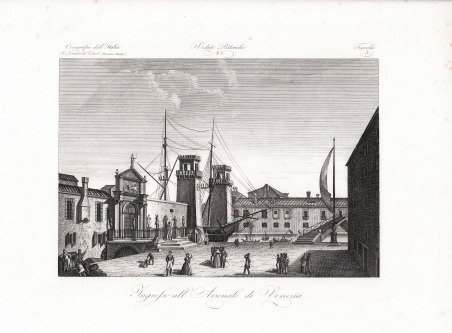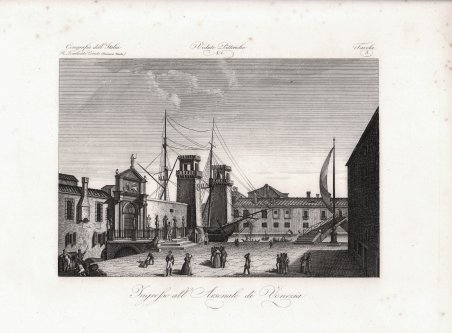UNA RARISSIMA PROVA DI STAMPA DEL TERZO STATO ' Acquaforte, bulino e puntasecca, circa 1745/48, firmata in basso a destra, nel foglio di destra. Esemplare nel terzo stato di sette descritto da Hind prima, con indirizzo e prezzo dello stesso Piranesi: Presso l’Autore a Strada Felice nel palazzo Tomati vicino alla Trinità de’ monti. A paoli due e mezzo. ' L’esemplare in questione, tuttavia, ' è da considerarsi come una rarissima prova di stampa, su due fogli separati, dividendo l’opera a metà e realizzando due composizioni fini a sé stesse. ' L’allegoria con la statua della Minerva costituirà il secondo frontespizio alle ' Vedute di Roma. ' Il lavoro viene datato dagli studiosi al periodo 1745/48, quindi venne realizzato prima del primo frontespizio all’opera, che è datato in lastra 1748. Per la realizzazione delle due composizioni, ottenute mediante la stampa dell’intera lastra, si servì molto probabilmente di una “mascherina”, riuscendo così a stampare solo metà della lastra. ' Il periodo in cui tutto ciò avviene lascia supporre che si tratti di un qualcosa di voluto e non di una semplice prova di stampa. Il soggetto – il capriccio – e le misure indicano come l’artista con questa prova di stampa, prosegua il lavoro che aveva iniziato nel 1743, con le prime tavole di ' Prima Parte di Architetture e Prospettive. Secondo Hind una prova di questo lavoro era presente inclusa nelle ' Opere Varie ' - nuovo titolo dato dal Piranesi alla ' Prima Parte di Architetture e Prospettive ' a partire dal 1750 - della King's Library, a conferma che il Piranesi usò la lastra per realizzare due nuovi lavori deposti a continuare ' Prima parte di Architetture e Prospettive. Prima parte di Architetture e Prospettive ' è una pubblicazione del giovane Piranesi, appena stabilitosi a Roma. Il risultato è un’opera non del tutto unitaria, caratterizzata dalla notevole differenza stilistica tra le tavole, ma dal grande fascino e che lascia intuire e prevedere i futuri sviluppi artistici. Il lavoro continua una tradizione di un modello ormai affermato, che prevedeva il capriccio e la veduta, la scenografia ed il trattato di architettura, ma in seguito, analizzando la biografia dell’artista si comprenderà essere soprattutto lo sfogo di una crisi come architetto e di un itinerario interiore vissuto con intensità. Insomma, il frutto dello scontro di una mente legata alla cultura veneziana erede della poesia delle rovine evocata da Marco Ricci e ripresa dal Bellotto e dal Canaletto, e la nuova cultura architettonica che si andava formando nel giovane Piranesi. ' Prima parte di Architetture ' e le successive fantasie architettoniche che la continuano costituiscono un passo decisivo verso lo scopo che egli si prefiggeva nella prefazione all’opera: far sì che il capriccio architettonico portasse a liberare l’architettura dalle catene del mondo materiale e sociale, per farne un’arte veramente liberale. Immediato fu il successo di pubblico che riscosse il lavoro. Come detto la prima stesura dell’opera è databile al 1743, e venne dedicata a Nicola Giobbe, grande impresario al servizio della Camera Apostolica e protettore del giovane architetto veneziano. In seguito, la stessa fu inserita in un più ampio discorso che comprendeva anche i quattro ' Capricci ' e pubblicata nelle ' Opere Varie di Architettura Prospettive Grotteschi Antichità Inventate ed incise da Giambattista Piranesi Architetto Veneziano ' stampata da Giovanni Bouchard nel 1750. ' Magnifica prova, impressa a inchiostro nero su due fogli separati, su carta vergata coeva con filigrana "doppio cerchio e giglio con lettere CB" (su entrambi i fogli), con ampi margini, tracce della consueta piega centrale orizzontale, nel complesso in eccellente stato di conservazione. Questa tiratura, stampata e venduta a Palazzo Tomati dallo stesso artista, è databile al 1760-1761 circa. Opera di grandissima rarità. ' Dimensioni: 322x495 mm il foglio di sinistra e . A VERY RARE PRINTING PROOF OF THE THIRD STATE Etching, engraving and drypoint, circa 1745/48, signed at lower right, in the right sheet. Example in the third state of seven described by Hind, with the imprint Presso l’Autore a Strada Felice nel palazzo Tomati vicino alla Trinità de’ monti. A paoli due e mezzo. The example in question, however, is to be considered as a very rare printing proof on two separate sheets, dividing the work in half and making two compositions for their own sake. ' ' The ' Allegory with the statue of Minerva ' will constitute the second title page to the ' Vedute di Roma. The work is dated by scholars to the period 1745/48, therefore it was realized before the first frontispiece to the work, which is dated on the plate 1748. For the realization of the two compositions, obtained by printing the entire plate, he most likely used a "mask", thus managing to print only half of the plate. ' ' The period in which all this took place suggests that it was something intentional and not a simple test. The subject - the caprice - and the measurements indicate that with these proofs the artist continued the work he had begun in 1743, with the first plates of the ' Prima parte di Architetture e Prospettive According to Hind, a proof of this work was included in the ' Opere Varie ' - the new title given by Piranesi to the ' Prima parte di Architetture e Prospettive ' from 1750 onwards - in the King's Library, confirming that Piranesi used the plate to make two new works to continue the ' Prima parte di Architetture e Prospettive. Prima parte di Architetture e Prospettive ' is a publication by the young Piranesi, who had just settled in Rome. The result is a work that is not entirely unified, characterized by the notable stylistic difference between the plates, but of great charm and that lets you guess and predict future artistic developments. The work continues a tradition of a well-established model, which included the whim and the view, the scenography and the treatise on architecture, but later, analyzing the artist's biography, it will be understood to be above all the outburst of a crisis as an architect and of an inner journey lived with intensity. In short, the result of the clash between a mind tied to Venetian culture, heir to the poetry of ruins evoked by Marco Ricci and taken up by Bellotto and Canaletto, and the new architectural culture that was forming in the young Piranesi. ' Prima parte di Architetture e Prospettive ' and the subsequent architectural fantasies that continue it constitute a decisive step towards the goal he set himself in the preface to the work: to ensure that architectural caprice would lead to free architecture from the chains of the material and social world, to make it a truly liberal art. The work was an immediate success with the public. As mentioned, the first edition of the work dates back to 1743, and was dedicated to Nicola Giobbe, a great impresario at the service of the Camera Apostolica and protector of the young Venetian architect. Later it was included in a wider discourse that included the four ' Capricci ' and published in the ' Opere Varie di Architettura Prospettive Grotteschi Antichità Inventate ed incise da Giambattista Piranesi Architetto Veneziano ' printed by Giovanni Bouchard in 1750. Magnificent proof, printed in black ink on two separate sheets, on contemporary laid paper with watermark "double encircled lily with letters CB" (in both sheets), with wide margins, traces of the usual central horizontal fold, overall, in excellent condition. This third issue, printed and sold at Palazzo Tomati by the artist himself, can be dated to around 1760-1761. Work of great rarity. ' ' Dimensions: 322x495 mm the left sheet and 330x495 mm the right sheet. Bibliografia cfr. A. M. Hind, ' Giovanni Battista Piranesi. A critical study with a list of his published works and detailed catalogues of the Prisons and Views of Rome ' (1908): p. 38, n. 2, III/VII; A. Robis. Cfr.



Descubre cómo utilizar
Descubre cómo utilizar

